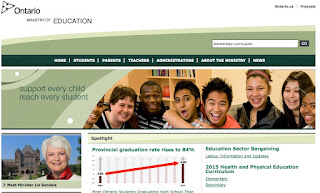The best way to to understand what curriculum documents look like is to actually look at them! At first they can be pretty overwhelming until you begin to see the patterns in the documents. The best way to do this is to carefully look at documents that are relevant to you. Looking at more than one document is also helpful because then you can compare different subject areas. In Ontario, curriculum documents are differentiated by subject areas and grade levels. You will find an Ontario curriculum document for each subject for grades 1 to 8. In secondary there is often a grade 9 and 10 version and a grade 11 and 12.
To find any curriculum document you go first to Ontario Ministry of Education. You can search for elementary curriculum or secondary curriculum in the Search bar in the right hand corner at the top of the page.
http://www.edu.gov.on.ca/eng/
Searching will take you to
http://www.edu.gov.on.ca/eng/curriculum/elementary/
OR
http://www.edu.gov.on.ca/eng/curriculum/secondary/index.html
Choose By Subject not By Grade.
From there you choose which curriculum document you wish to look at.
Look Fors:
1. Table of Contents
2. Front Matter - Everything written before Strands and Expectations . Some documents have much more than others in the Front Matter. The front matter will tell you the philosophy behind the document and what is considered most important for a student to Know, Do and Be in the subject area from K to 12.
3. Assessment & Evaluation & Achievement Charts. What is most important for a student to Know, Do and Be?
4. Overall Layout: How is the subject area presented in the document? (For example, Social Studies grades1 to 6 is one subject area divided into Strands. In Grade 7 and 8 there is History and Geography and each subject area is divided into Strands. In Grades 9 and 10 the documents identifies history, geography and civics (politics). This document is called The Ontario Curriculum Grades 9 and 10 Canadian and World Studies. Similarly the grades 11 and 12 document is also Canadian and World Studies. Other subjects are more straight forward.
What subtopics or STRANDS are in each grade? Does this follow through for every grade or do the STRANDS change?
4. Look at one grade, one strand.
What are the Overall Expectations?
What are the titles of the Specific Expectations?
Are there examples of how a teacher might help students to meet the expectations?
Are there suggestions for what Big Ideas (KNOW) that might be taught?
Are there suggestions for what Big Skills (DO) that might be taught?
Is there any mention of teaching values (BE)?
What are the titles of the Specific Expectations?
Are there examples of how a teacher might help students to meet the expectations?
Are there suggestions for what Big Ideas (KNOW) that might be taught?
Are there suggestions for what Big Skills (DO) that might be taught?
Is there any mention of teaching values (BE)?
Look at another Strand in the same grade, same subject. Are the answers to the above questions the same or different?
5. Unifying framework In Ontario, there is no unifying framework. There is nothing to tell you what should be taught across all subject areas K to 12. This is because each subject area creates its own documents and is only loosely guided by an overall vision. You will probably find that other countries or provinces provide an overall vision. Look at Hong Kong's 7 Goals for all Learners.
And the unifying framework for all subjects, all grades
Source: unknown
There is no unifying framework in Ontario. But what does your document say about
- the environment?
- healthy relationships?
- mental health, well- being?
- equity?
- financial literacy?
- mathematical literacy?
- inquiry?
- critical thinking and critical literacy?
- technology?
- 21st Century education?
- ways of learning?
Front Matter Assignment:
Here you will apply the "theory" of Chapter 2 to the Front Matter of one subject area from Ontario and the same subject area from somewhere else - outside Ontario. So, you will be comparing and contrasting two documents from two different jurisdictions. To do this most effectively you want to compare the same subject area and same "strand" (although it may not be called a strand). Choose another jurisdiction. Use the same process as above to find a similar curriculum document from another country or another province. Sometimes it is not called a Ministry of Education, there may be another name such as Education Bureau, but with a little exploring you should be able to locate what you want from where you want it. And don't forget you can choose Google Translate if you are looking at a country where you do not understand the language. Basically you are looking for the KDB in the front matter.
You are asked to choose a graphic organizer or mind map to show your thinking. Some suggestions for a compare and contrast graphic organizer are found at this link. Or you can create one on your own. We also want some thoughtful discussion on the content of the Front Matter and what you found. The rubric for this task is in Resources. BUT, you can't really do this fully until we discuss the Chapter 2 reading next week. Getting familiar with the documents for next week and the Chapter 2 reading will take you a long way to where you need to be for the Front Matter assignment AND the curriculum design.
This blog is supposed to give your a head start on the Front Matter and Curriculum Design. I hope that it does not just confuse you more. So take a stab at it and if you don't understand it perfectly know that there is still time and things will become clearer in class. ...
http://www.bensalemsd.org/Page/10808
Until next week!






No comments:
Post a Comment